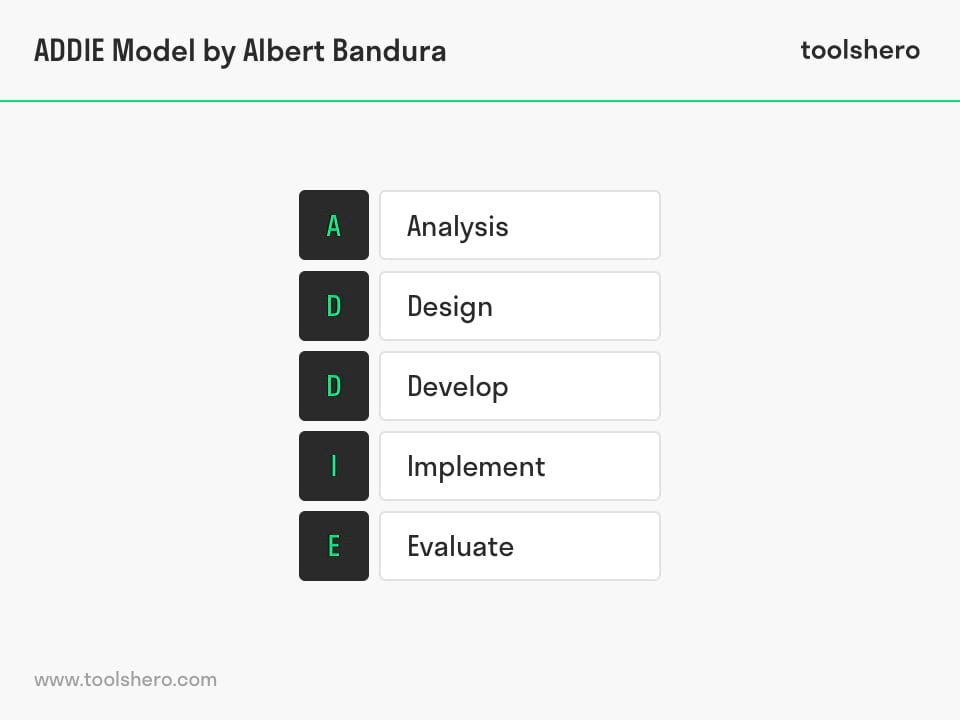ADDIE Model of Instructional Design explained

ADDIE model: this article describes the ADDIE Model of Instructional Design in a practical way. Next to what it is, this article highlights the five stages and a short summary. After reading, you’ll understand the basics of this implementation and development tool. Enjoy reading!
What is the ADDIE Model?
The ADDIE model is an acronym for the five stages of this waterfall model, which are:
- Analysis – Determining the problem, possible solution or desired situation.
- Design – Using the analysis results to come up with a design principle.
- Development – The idea or design principle is developed into a prototype, a first product.
- Implementation – The idea or design principle is implemented. This process is iterative, meaning it is repeated to reach the optimal result.
- Evaluation – Every solution or implemented process is evaluated in order to optimise it.
The ADDIE model originated in education. The origins of the ADDIE model are difficult to retrace, because it was never fully developed.
The ADDIE model is an informal term for the waterfall model, which is also called the V model. This model is presumed to have been developed by the Center for Educational Technology at Florida State University at the request of the American army. It is one of the most widely used methods in the development of educational processes.
This method is also called the ISD (Instruction System design). The standard model for educational design is a framework meant to assist in the development of effective training programmes, but it is mainly used in project management.
The ADDIE Model of Instructional Design can be used for the development of both individual and traditional educational processes. The model is also known as the intervention cycle, the counterpart of Adriaan de Groot’s empirical cycle.
Five stages of the ADDIE model
Stage 1 of the ADDIE model: Analysis
In this first stage, the educational challenge is defined. The desired principles are analysed, discussed and developed. All relevant data are collected in order to guarantee the success of the design during the entire process. Some aspects that need to be considered are:
- The goals (desired results)
- The necessary knowledge (target audience)
- The available means (budget, time, electronics, staff)
It is essential to meet these conditions before the solution or challenge can be realised. Practical matters, such as the expected number of students or trainees, also need to be defined during the analysis process.
After the analysis has been completed, a clear image is developed of the ‘shortages’ to be bridged between existing knowledge and desired results.
Stage 2 of the ADDIE model: Design
In the design stage, the so-called blueprint is created. A blueprint contains all the crucial elements or building blocks of the design. The necessary specifications that need to be determined are, amongst others:
- Learning goals
- The content (quality, existing content, additional content)
- Assessment tools (evaluation)
- Format (e-learning, classroom, group activities, own pace)
- Assignments (practical training)
- Planning
- Media usage
The above aspects are developed into a design plan. This is where structure is given to the plan. When the design plan is complete and clear enough, you can move to the development stage.
Stage 3 of the ADDIE model: Development
During the development stage, the design is realised. The entire educational process is tested in order to ensure no further development will be needed later.
During this stage, the first clear progress is established. The previously abstract ideas and methods get clear outlines in the development stage.
Testing the new educational process provides organisations with the opportunity to implement changes before the costs get too high. The following aspects are important:
- Didactics Assigning the most efficient method per learning goal to transfer the knowledge and skills to the learner (e-learning, classroom, etcetera)
- The complete implementation of the pilot process, including a feedback system to monitor the effectiveness
Stage 4 of the ADDIE model: Implementation
In the implementation stage, the final product is presented to the learner. This can be done with lessons, courses or lectures. Before the prepared design plan can be used in practice, a project plan must be created.
This project plan provides clarity on the manner in which the learning arrangement will be implemented. For example, a lesson series can be implemented and tested in a classroom in the form of a pilot.
The series can then be evaluated and possibly adjusted. When the lessons have been optimised, it is possible to implement them in multiple classes or have them executed by multiple teachers. The following, amongst other things, is considered during the implementation stage:
- The coaching of the student or trainee
- The preparation of teachers
- Determining the overlap with teaching material of other teachers
- The design of the electronic learning environment (ELE)
- The testing and implementing of teaching materials and media
Stage 5 of the ADDIE model: Evaluation
As mentioned, evaluation is an aspect that comes back during all five of the processes. Evaluation is like a security guard for the gates of failure. Response is collected after the instructions, the teaching materials, have been presented to the learner, by having them fill in feedback forms.
After analysing this input, the teaching value is measured to see whether the prototype is sufficiently relevant, consistent and effective. Evaluation can be done in several ways, but to get to a qualitatively good lesson or instruction, evaluation is in any case a requirement.
To summarise the ADDIE model
The five stages that cover the entire process need to be carefully considered to design a lesson or teaching plan that appeals to students.
The core activities analysis, design, development and implementation follow each other in the first four stages of the ADDIE model. After the educational goals have been defined, a blueprint is drawn up.
During the third stage, development, it is determined which didactical methods suit the subject matter best.
During the penultimate stage, the design plan is implemented in practice. Continuous monitoring and evaluation need to take place in order to transfer knowledge and skills to the learner as effectively and efficiently as possible.
Evaluation is a continuous activity that comes back at every sub-stage to be able to adjust when necessary.
It’s Your Turn
What do you think? Do you recognise the explanation of the ADDIE model? Do you recognise the different stages in your own learning environment or do you have other ideas? Are there any tips you would like to share about the implementation of new teaching methods or on learning new skills?
Share your experience and knowledge in the comments box below.
More information
- Kruse, K. (2002). Introduction to instructional design and the ADDIE model. Retrieved January, 26, 2005.
- Morrison, G. R., Ross, S. M., & Kemp, J. E. (2007). Designing effective instruction (5th Ed.). Hoboken, Wiley & Sons.
- Peterson, C. (2003). Bringing ADDIE to Life: Instructional Design at Its Best. Journal of Educational Multimedia and Hypermedia, 12(3), 227-241.
How to cite this article:
Janse, B. (2018). ADDIE Model of Instructional Design. Retrieved [insert date] from Toolshero: https://www.toolshero.com/change-management/addie-model/
Original publication date: 03/14/2018 | Last update: 02/20/2024
Add a link to this page on your website:
<a href=”https://www.toolshero.com/change-management/addie-model/”>Toolshero: ADDIE Model of Instructional Design</a>







